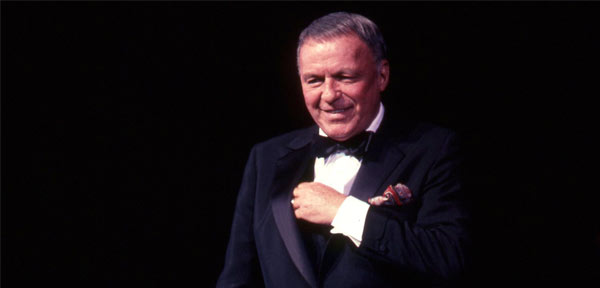The Voice of A Generation
By John McDonough
There was more to the Greatest Generation than Roosevelt, the New Deal, and Normandy. There was its music: Gershwin, Ellington, Porter, Fitzgerald, Crosby, Berlin, Rodgers, Kern, Armstrong, Goodman, Holiday, Shaw, Miller. Nothing like it, before or since. And there was Sinatra.
In the late summer of 1939 an unknown Frank Sinatra first came to Chicago as a band singer, spending seven weeks in the Sherman House Hotel across from City Hall. Some may have heard him, but none could have guessed his future. More than half a century later, in 1994, he returned to Chicago for the last time; more than 20,000 fans saw him then in the United Center.
In the 55 years between the Sherman House and the United Center, Sinatra bent the axis of American music to his will, and there were milestones in that process that played out in Chicago. But they didn’t come suddenly; instead, they came in phases through a procession of Sinatras—each added layers of emotional identity to the one that had come before. As he grew as an artist, he grew larger in our imaginations. As he grew into his songs (and then beyond them), the songs grew with him. By the time he finally stepped down, what had once been considered simply pop tunes had become an honored repertory—the Great American Songbook.
September 15, 1939: “This young Frank Sinatra handles the ballads”
Frank Sinatra is said to have played Chicago as part of a Major Bowes Amateur Hour road show in the fall of 1935, but any evidence has long since been lost. His first confirmed appearance in the city was with the Harry James Orchestra, opening Friday, September 15, 1939, in the Panther Room of the Sherman House Hotel. For the next several weeks anyone willing to pay 75 cents could go to Clark and Randolph Streets and be present for the genesis. Nearly every hot swing band carried a “boy singer,” and James had only eight weeks earlier picked up Sinatra while he was performing in the Rustic Cabin in Englewood Cliffs, NJ. Sinatra came to Chicago as one band singer among many; all were romantic, though Sinatra didn’t yet look the part. But with only radio and records as the music media, sex appeal still resided in the voice and the imagination, not the eye. “This young Frank Sinatra handles the ballads,” James told Chicago-based DownBeat magazine at the time. “We think he is doing a fine job.”
December 21, 1939: “He’s nothing to look at, but he’s got a sound”
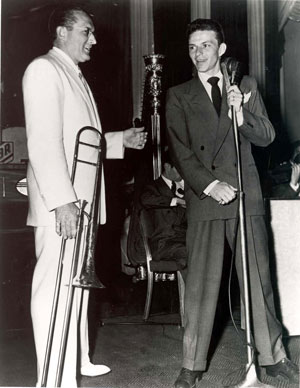 It was in Chicago that Sinatra’s stars first began to seriously align. The Tommy Dorsey Orchestra moved into the prestigious Empire Room of the Palmer House on October 12. Sinatra, who was still working two blocks away at the Sherman, knew that Dorsey was looking to replace his singer, Jack Leonard. One day in the Wrigley Building, a CBS radio music executive asked Dorsey if he’d ever seen Sinatra. “He’s nothing to look at, but he’s got a sound,” he told Dorsey. “My back was to the bandstand, but when the kid started taking a chorus, I had to turn around.”
It was in Chicago that Sinatra’s stars first began to seriously align. The Tommy Dorsey Orchestra moved into the prestigious Empire Room of the Palmer House on October 12. Sinatra, who was still working two blocks away at the Sherman, knew that Dorsey was looking to replace his singer, Jack Leonard. One day in the Wrigley Building, a CBS radio music executive asked Dorsey if he’d ever seen Sinatra. “He’s nothing to look at, but he’s got a sound,” he told Dorsey. “My back was to the bandstand, but when the kid started taking a chorus, I had to turn around.”
Sinatra left Chicago with James in early November. But the band swung back through town in mid-December for a one-week stand at the Chicago Theatre. Sinatra was still a nobody; the theater manager called him a “scarecrow.” But the night before closing on December 20, James agreed to play Mayor Ed Kelly’s “Night of Stars” gala in the Chicago Stadium. Dorsey’s band was also on the program, but he may or may not have heard Sinatra that night; the show ran seven hours through 40 acts. Nonetheless, Sinatra met him the next afternoon in his suite in the Palmer House. Dorsey led the most popular band in the country, had a weekly radio show, and was building a showboat of talent that included Buddy Rich, Sy Oliver, Paul Weston, Axel Stordahl, and a stock company of singers. He offered Sinatra $125 to come on board, and Sinatra accepted.
On January 26, 1940, Sinatra took a train to Rockford, IL, where that night at the Coronado Theater he stepped in front of the Dorsey band for the first time. A week later the band returned to Chicago for a brief stop at the Merchandise Mart where Sinatra made the first of what would be 83 records with Dorsey: “The Sky Fell Down” and “Too Romantic.”
July 16, 1942: The beginnings of a personal songbook
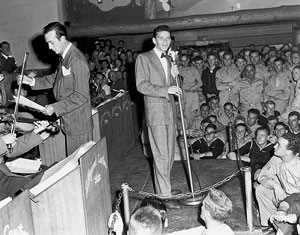 Sinatra would not be back in Chicago for two and a half years, but when he did return he was a different Sinatra—on the threshold of uncharted stardom and eager to get on with it. “No doubt half the town will be journeying to the Chicago Theatre this week to hear Tommy Dorsey and his celebrated orchestra,” the Chicago Tribune (correctly) predicted. A week later, when the band left, it had set a summer attendance record. Sinatra was becoming a force. He was now being billed in the ads, first among the featured talents. More important, he had built the beginnings of a personal songbook with Dorsey that he would forever carry: “I’ll Be Seeing You,” “East of the Sun,” “Street of Dreams,” “Without a Song,” “Violets for Your Furs,” “The Song Is You,” “Stardust,” and “I’ll Never Smile Again.” But six weeks later Sinatra departed Dorsey’s lineup and never looked back.
Sinatra would not be back in Chicago for two and a half years, but when he did return he was a different Sinatra—on the threshold of uncharted stardom and eager to get on with it. “No doubt half the town will be journeying to the Chicago Theatre this week to hear Tommy Dorsey and his celebrated orchestra,” the Chicago Tribune (correctly) predicted. A week later, when the band left, it had set a summer attendance record. Sinatra was becoming a force. He was now being billed in the ads, first among the featured talents. More important, he had built the beginnings of a personal songbook with Dorsey that he would forever carry: “I’ll Be Seeing You,” “East of the Sun,” “Street of Dreams,” “Without a Song,” “Violets for Your Furs,” “The Song Is You,” “Stardust,” and “I’ll Never Smile Again.” But six weeks later Sinatra departed Dorsey’s lineup and never looked back.
May 17, 1946: “The Voice” and the “Jennies”
After the war Sinatra was a national sensation. He had become a rolling dynamo of sexual magnetism, able to ignite young passions with a whispered rubato or the intimate swerve of note from sharp to flat. He was “The Voice,” according to his first album. During the previous few years, Chicagoans had brief glimpses of this emergent and puzzling power. The venue was always the Dearborn Street Station, the transfer point of the nation’s Who’s Who as they arrived from Los Angeles on the Super Chief and departed for New York on the Twentieth Century a few blocks away. In 1943 the local press began to cover Sinatra’s brief layovers and the small riots that broke out as hundreds of swooning fans—“stage door Jennies”—stampeded the station hoping to touch him.
 When Sinatra returned for his third time to the Chicago Theatre, fans began lining up at dawn, four abreast. “Something new has been added to the stage show,” the Tribune noted. “A brace of burly policeman arranged ... in plain sight at both sides of the stage.” In the new frontier of fame that Sinatra was exploring, “security” was on its way to becoming a permanent part of the concert landscape. The pandemonium went on all week. The irony was that nothing Sinatra was doing invited such mayhem. He sang magnificent love songs (“I’ve Got a Crush on You,” “Someone to Watch Over Me,” “You Go to My Head”) and serious concert pieces (“Soliloquy” from Carousel). He seemed as baffled by it all as the cultural anthropologists who scrambled to suss out the reasons.
When Sinatra returned for his third time to the Chicago Theatre, fans began lining up at dawn, four abreast. “Something new has been added to the stage show,” the Tribune noted. “A brace of burly policeman arranged ... in plain sight at both sides of the stage.” In the new frontier of fame that Sinatra was exploring, “security” was on its way to becoming a permanent part of the concert landscape. The pandemonium went on all week. The irony was that nothing Sinatra was doing invited such mayhem. He sang magnificent love songs (“I’ve Got a Crush on You,” “Someone to Watch Over Me,” “You Go to My Head”) and serious concert pieces (“Soliloquy” from Carousel). He seemed as baffled by it all as the cultural anthropologists who scrambled to suss out the reasons.
June 9, 1952: “Time has marched on”
By the summer of 1952, when Sinatra came back to Chicago for a week at the Chez Paree, the mayhem has subsided. Except for two brief Knights of Columbus events in 1946 and ’47 and a benefit at the Opera House in 1950, it was his first major Chicago appearance in six years. The Chez Paree had the kind of old-fashioned, velvety swank you see only in 1940s movies now. The adult nightclub setting accommodated around 900 and offered dinner, dancing, and floor shows featuring the biggest stars in show business. It was Sinatra’s natural habitat— a smallish saloon where the intimacy of the performance correlated to the space it occupied—but he was in a slump. Columbia Records and MCA had dropped him that summer, and the crowds weren’t coming.
Chicago columnists covered his Chez Paree stand as if he were a nostalgia act. “It’s difficult to realize it was nine years ago that Frank Sinatra swept across the American scene,” wrote Will Leonard in the Tower Ticker. “Time has marched on, and Sinatra looks strangely dated. Ask a youngster of 16 today what she thinks of Sinatra and she’ll look at you as if you were dredging up something from the horse-and-buggy age. Outside [the Chez] on opening night there was no trace of a juvenile toting an autograph book. Times have changed.” It would be another 10 years before Chicago would see Sinatra again, but when it did, he would be the coolest man in the world.
November 26, 1962: “Madness at the Villa”
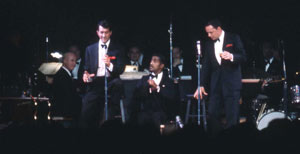 This writer’s first in-person glimpse of Sinatra’s furious magnetism, which had been reconstructed into a pillar of the American power structure itself, happened in the most unexpected place you could imagine—a fading roadhouse called the Villa Venice, tucked along an unincorporated stretch of Milwaukee Avenue just south of Palatine Road. But there was more. Not only did Sinatra play two shows a night, but so, too, did Rat Pack members Dean Martin and Sammy Davis Jr.
This writer’s first in-person glimpse of Sinatra’s furious magnetism, which had been reconstructed into a pillar of the American power structure itself, happened in the most unexpected place you could imagine—a fading roadhouse called the Villa Venice, tucked along an unincorporated stretch of Milwaukee Avenue just south of Palatine Road. But there was more. Not only did Sinatra play two shows a night, but so, too, did Rat Pack members Dean Martin and Sammy Davis Jr.
When he walked onstage unannounced after Martin’s 20 minutes, he radiated certainty. The humor was mostly PG, but not PC. There may not have been any four-letter words uttered, but a lot of the hoary gags would not pass today’s public standard. Davis seemed to draw a million race jokes, but for all the cracks, you knew those brothers were there for each other.
Like some suburban Brigadoon, the Villa Venice was incendiary for seven brief days, then poof, it was gone. Herb Lyon called it “Madness at the Villa ... where some 2,000 screaming fans turned out to pay homage to show biz royalty.” Sinatra was the king among kings. But when he left, the Villa went dark.
July 11, 1967: The arena Sinatra
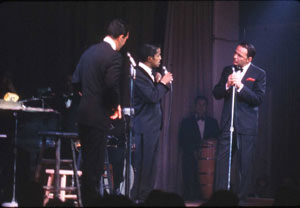 By 1967 the Baby Boomers had made music an arena-size attraction, and the economics of entertainment were changing. Sinatra was perhaps the only figure from the pre-war era with the momentum to compete in that league. That July, backed by the Buddy Rich band, he played his first solo arena event in Chicago to a crowd of 15,000 in the International Amphitheater, the equivalent of 16 Villa Venice shows in one performance. Though Sinatra sacrificed intimacy for efficiency, his audience, including new generations of fans he’d picked up in the ’50s and early ’60s, were more than willing to bring their binoculars. According to Tribune critic Tom Willis, Sinatra at 51 “still [had] what it takes.”
By 1967 the Baby Boomers had made music an arena-size attraction, and the economics of entertainment were changing. Sinatra was perhaps the only figure from the pre-war era with the momentum to compete in that league. That July, backed by the Buddy Rich band, he played his first solo arena event in Chicago to a crowd of 15,000 in the International Amphitheater, the equivalent of 16 Villa Venice shows in one performance. Though Sinatra sacrificed intimacy for efficiency, his audience, including new generations of fans he’d picked up in the ’50s and early ’60s, were more than willing to bring their binoculars. According to Tribune critic Tom Willis, Sinatra at 51 “still [had] what it takes.”
April 26–27, 1974 and beyond: Sinatra at cruising speed
After his famous “retirement” concert in 1971, and as his movie career wound down, Sinatra’s touring schedule ramped up and the venues got ever bigger. Two April 1974 concerts in the Chicago Stadium drew nearly 40,000 people. A new generation of critics held the 60-year-old Sinatra up to the younger versions they’d heard about. They probed his performances for telltale cracks in the mortar—a wayward pitch, a tiny frog—but it was irrelevant. The arc of his fame was beyond the reach of any critic’s second guessing. He was now at cruising speed in the calm stratosphere of his own legend.
Sinatra returned to the stadium in May 1975, in September (with Ella Fitzgerald and Count Basie), and again in October 1978. Then he passed six nights at the Arie Crown Theater in February 1979. But he drew by far the largest Chicago crowd of his career on August 10, 1982, when an enormous, multi- generational audience of 50,000 cheered Sinatra at Navy Pier in a free ChicagoFest performance. More Chicagoans saw Sinatra in those few years than in the previous 40 combined. “Forget about farewells, he seemed to be saying,” Larry Kart wrote in the Tribune. “You’re as young as you feel, and I feel great.”
June 7, 1977; September 10, 1986; and March 19, 1988: Some sentimental journeys
In 1977 Sinatra grew nostalgic for the low ceilings, clinking glasses, and smoky air of the few old-fashioned nightclubs that still remained outside Las Vegas. One of them was the Sabre Room on 95th Street in Hickory Hills, where for four nights in June 1977 Sinatra and Martin played their last Chicago-area cabaret gig. But even the $100-per-person cover charge didn’t scare away the customers; it was a sellout.
Even if the nightclub era was to be consigned to the past, on September 10, 1986, Sinatra and Count Basie’s band helped assure that one of the city’s great entertainment landmarks, the Chicago Theatre, would have a future. The palace he had first played nearly a half century before with Harry James was reopening after a $9 million restoration. Sinatra’s final Chicago Theatre date came 18 months later and would be a valedictory both triumphant and melancholy. In 1988 the Rat Pack reunited for a sellout national tour, reaching Chicago on March 19 and playing three weekend performances in the same theater where Ocean’s Eleven had opened in 1960. Conceding little to the passage of 25 years, the threesome of Frank, Dean, and Sammy posed a glamorous reminder of the vanishing show business of cocktails and tuxedos. “Show biz,” a spellbound Rick Kogan wrote, “in all its freewheeling glory.” It would never be seen again. Dean Martin was hospitalized the next day and never returned to the tour. The Rat Pack came to an end in Chicago.
October 21, 1994: The Final Curtain
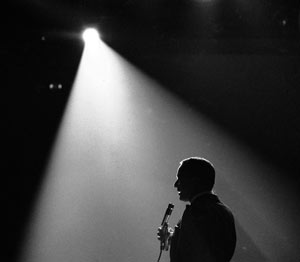 In August 1993 Sinatra presided over the three-night baptism of the Hollywood Casino in Aurora. Using prompters to help him with lyrics and son Frank Jr. to conduct, some thought it might be his final Chicago stand. But there was still the United Center to open. Billy Joel and Eric Clapton could only be warm-up acts so long as Sinatra lived to crack the champagne bottle on October 21, 1994. “I had the ominous feeling that this would be the last time dad would perform in Chicago,” Nancy Sinatra wrote later on. “And I believe he had the same feeling.” Yet, sitting in the third row among 20,000 fans and watching Sinatra in action, this writer believed he’d see him again. No one had to cut him any slack. It was a heroic show. The Tribune’s Howard Reich would be the last in a 55-year procession of critics to judge a Sinatra concert. He pronounced him “still top of the heap.”
In August 1993 Sinatra presided over the three-night baptism of the Hollywood Casino in Aurora. Using prompters to help him with lyrics and son Frank Jr. to conduct, some thought it might be his final Chicago stand. But there was still the United Center to open. Billy Joel and Eric Clapton could only be warm-up acts so long as Sinatra lived to crack the champagne bottle on October 21, 1994. “I had the ominous feeling that this would be the last time dad would perform in Chicago,” Nancy Sinatra wrote later on. “And I believe he had the same feeling.” Yet, sitting in the third row among 20,000 fans and watching Sinatra in action, this writer believed he’d see him again. No one had to cut him any slack. It was a heroic show. The Tribune’s Howard Reich would be the last in a 55-year procession of critics to judge a Sinatra concert. He pronounced him “still top of the heap.”
Sinatra remained a force longer than any performer of his era. His presence and his music penetrated a succession of generations. Now, the further Frank Sinatra and his music slip from the sentiments of nostalgia into the emotional neutrality of history, the more we will appreciate how good it all really was.
Frank Sinatra's music lives on in the Sinatra Centennial on September 4 at Ravinia with Frank Sinatra Jr.

